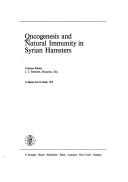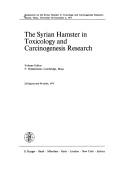| Listing 1 - 7 of 7 |
Sort by
|
Article
Year: 1967
Abstract | Keywords | Export | Availability | Bookmark
 Loading...
Loading...Choose an application
- Reference Manager
- EndNote
- RefWorks (Direct export to RefWorks)
Behavior. --- Hamster. --- Learning. --- Mesocricetus auratus. --- Mesocricetus-auratus.
Article
Abstract | Keywords | Export | Availability | Bookmark
 Loading...
Loading...Choose an application
- Reference Manager
- EndNote
- RefWorks (Direct export to RefWorks)
Development. --- Hamster. --- Inbreeding depression. --- Mesocricetus auratus. --- Mesocricetus-auratus. --- Rodent. --- Syrian-hamster.

ISBN: 3805528248 Year: 1979 Publisher: Basel ; München ; Paris : Karger,
Abstract | Keywords | Export | Availability | Bookmark
 Loading...
Loading...Choose an application
- Reference Manager
- EndNote
- RefWorks (Direct export to RefWorks)
Cancer --- -Golden hamster --- -Viral carcinogenesis --- Microbial carcinogenesis --- Oncogenic viruses --- Hamster, Golden --- Hamster, Syrian --- Mesocricetus auratus --- Syrian hamster --- Mesocricetus --- Cancers --- Carcinoma --- Malignancy (Cancer) --- Malignant tumors --- Tumors --- Immunological aspects --- Diseases --- Golden hamster --- Viral carcinogenesis --- Carcinogenesis
Article
Abstract | Keywords | Export | Availability | Bookmark
 Loading...
Loading...Choose an application
- Reference Manager
- EndNote
- RefWorks (Direct export to RefWorks)
Physical aspects of the laboratory environment, such as type of cage or bedding, are often ignored by investigators but may be quite important for the animals. We examined whether golden hamsters preferred living in wire mesh floored, stainless steel cages or solid floored, plastic cages with corn-cob litter. Forty hamsters of 2 ages were housed in wire or solid floored cages for 3 weeks. Caging preference was then tested using a choice apparatus in which hamsters could move freely between the 2 cages for 6 days. Scan data were collected on cage occupation and behaviour. Results showed that most hamsters preferred the solid floored cage with litter, but prolonged experience on wire led to a wire floored cage preference in 40% of these animals. Also, wire-housed hamsters showed higher levels of hoarding and lower levels of gnawing behaviour during testing, and spent significantly different amounts of time from litter-housed hamsters performing sleeping, exploring, grooming, gnawing, eating, and hoarding behaviours while on solid floored cages with litter. This study shows that previous housing condition can affect cage preferences and behaviour and supports the assertion that husbandry practices can be better evaluated by asking laboratory animals, rather than only humans, how their living conditions are perceived
Age. --- Animal. --- Animals. --- Bedding. --- Behavior. --- Behaviour. --- Cage. --- Caging. --- Choice. --- Environment. --- Experience. --- Golden hamster. --- Golden hamsters,caging preferences,preference testing,animal husbandry. --- Golden-hamster. --- Golden-hamsters. --- Grooming. --- Hamster. --- Hamsters. --- Hoarding. --- Housing. --- Human. --- Humans. --- Husbandry. --- Laboratory animals. --- Laboratory environment. --- Laboratory-animals. --- Laboratory. --- Level. --- Mesocricetus auratus. --- Mesocricetus-auratus. --- Mice. --- Physical. --- Preference. --- Preferences. --- Time.
Article
Abstract | Keywords | Export | Availability | Bookmark
 Loading...
Loading...Choose an application
- Reference Manager
- EndNote
- RefWorks (Direct export to RefWorks)
In order to assess the importance of different enrichment items in cages, a continuous successive choice test was performed with groups of Him:OF1 mice. 32 juvenile mice of both sexes were tested in groups of 4, and 12 adult females were tested two by two. Total duration varied between 7 and 14 days. The 4 test cages were structured as follows: [A] nest box, paper tissues, cardboard roll; [B] paper tissues, cardboard rolls; [C] nest box, paper tissues; [D] no additional structures. The animals' behaviour was recorded by video and observed by instantaneous sampling. After the animals had made their choice, the preferred cage was emptied, and the test repeated with the 3 other test cages structured as before. After the animals had again made their choice, the second preferred cage was emptied also, and the test repeated with 2 cages structured as before. 10 of the 14 groups preferred cage A, followed by cage C and then B. Daily nest site location was confirmed by the video observations: During the light periods, the preference for a cage with nestbox was significant. With rare exceptions, all the mice from one group rested together in one communal nest. Second priority was attached to the cage with nesting material and tubes. Cage D with wooden granule only was generally less occupied than the furnished test cages, and avoided during the light periods. Thus the animals made a clear ranking of preference, which was well correlated with the biological significance of cage structures. In accordance with results from preference tests with individually housed mice, present results support the view that nesting materials, shelter, social contact and adequate space are important environmental features for laboratory mice
Adult. --- Aggression. --- Animal. --- Animals. --- Behavior. --- Behaviour. --- Boxes. --- Cage. --- Choice test. --- Choice. --- Contact. --- Domestication. --- Duration. --- Enrichment. --- Environmental enrichment. --- Female. --- Females. --- Group. --- Hamsters mesocricetus-auratus. --- House mice. --- Inbred strains. --- Laboratory mice. --- Laboratory. --- Light. --- Mice.
Article
Abstract | Keywords | Export | Availability | Bookmark
 Loading...
Loading...Choose an application
- Reference Manager
- EndNote
- RefWorks (Direct export to RefWorks)
We examined the effects of the absence of the pineal gland on testicular maintenance and regression in adult male Mongolian gerbils. Pinealectomized and control gerbils were maintained in different photoperiods (0 L, 8 L, 14 L, or 24 L), and body weights and testicular maintenances were investigated. Testes sizes and body weights were measured every week for ten weeks. Body weight did not change during the course of the experiment in all photoperiods. In testes weights, there was no difference between pinealectomized and control groups in the 14 L photoperiod (p > 0.05), while there was a significant difference between pinealectomized and control groups in 0 L, 8 L, and 24 L photoperiods; in control groups there was a regression in testes weights. These results demonstrate that photoperiod does not affect the regulation of body weight, but it does affect the reproductive system of Mongolian gerbils. Thus, the pineal gland plays an important role. in the transduction of photoperiodic information
Absence. --- Adult. --- Body weight. --- Body-weight. --- Boxes. --- Control. --- Experiment. --- Gerbil. --- Gerbils. --- Gland. --- Gonads. --- Group. --- Hamsters. --- Maintenance. --- Male meadow voles. --- Male mongolian gerbils. --- Male. --- Melatonin. --- Meriones unguiculatus. --- Meriones-unguiculatus. --- Mesocricetus-auratus. --- Mongolian gerbil. --- Mongolian gerbils. --- Mongolian-gerbil. --- Pelage color. --- Phodopus-sungorus. --- Photoperiod. --- Pineal. --- Play. --- Regulation. --- System. --- Time. --- Turkey. --- Unguiculatus. --- Weight.

ISBN: 3805528906 Year: 1979 Publisher: Basel ; München ; Paris : Karger,
Abstract | Keywords | Export | Availability | Bookmark
 Loading...
Loading...Choose an application
- Reference Manager
- EndNote
- RefWorks (Direct export to RefWorks)
Carcinogens. --- Cricetinae. --- Neoplasms, Experimental --- Toxicology. --- Cancer --- -Carcinogenesis --- -Golden hamster --- -Hamsters as laboratory animals --- -Toxicology, Experimental --- -Experimental toxicology --- Laboratory animals --- Hamster, Golden --- Hamster, Syrian --- Mesocricetus auratus --- Syrian hamster --- Mesocricetus --- Oncogenesis --- Pathogenesis of cancer --- Tumorigenesis --- Pathology --- Genetic toxicology --- Cancers --- Carcinoma --- Malignancy (Cancer) --- Malignant tumors --- Tumors --- Evidence Based Toxicology --- Evidence-Based Toxicology --- Toxinology --- Based Toxicologies, Evidence --- Based Toxicology, Evidence --- Evidence Based Toxicologies --- Evidence-Based Toxicologies --- Toxicologies, Evidence Based --- Toxicologies, Evidence-Based --- Toxicology, Evidence Based --- Toxicology, Evidence-Based --- Pharmacogenetics --- Cricetus --- Hamsters --- Hamster --- Oncogens --- Tumor Initiators --- Tumor Promoters --- Initiators, Tumor --- Promoters, Tumor --- Benzidines --- Neoplasms --- etiology. --- Animal models --- -Congresses --- Congresses --- Physiology --- Pathogenesis --- -etiology. --- Carcinogenesis --- Golden hamster --- Hamsters as laboratory animals --- Toxicology, Experimental --- Carcinogens --- Cricetinae --- Toxicology --- Experimental toxicology --- Animal models&delete& --- Physiology&delete& --- etiology --- Carcinogen --- Oncogen --- Tumor Initiator --- Tumor Promoter --- Initiator, Tumor --- Promoter, Tumor
| Listing 1 - 7 of 7 |
Sort by
|

 Search
Search Feedback
Feedback About UniCat
About UniCat  Help
Help News
News